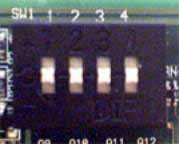AOpen AK73-1394 Socket-A KT133 ATX
by Mike Andrawes on January 21, 2001 3:29 AM EST- Posted in
- Motherboards
The same ol' overclocking features
 AOpen
has done a lot to help users overclock their Socket-A processors, and the same
features are implemented on the AK73-1394. By
now most of you know that overclocking Athlon and Duron processors by changing
the multiplier ratio is the best way, and AOpen includes the necessary components
you need to do that. A set of 4 dipswitches is located on the right edge of
the PCB, which provides users with sixteen settings between 5 and 12.5.
AOpen
has done a lot to help users overclock their Socket-A processors, and the same
features are implemented on the AK73-1394. By
now most of you know that overclocking Athlon and Duron processors by changing
the multiplier ratio is the best way, and AOpen includes the necessary components
you need to do that. A set of 4 dipswitches is located on the right edge of
the PCB, which provides users with sixteen settings between 5 and 12.5.
In terms of FSB speeds, AOpen stays with the same set of values found on the AK73 Pro, which include 100 / 102 / 104 / 106 / 107 / 108 / 109 / 110 / 111 / 112 / 113 / 114 / 115 / 116 / 118 / 120 MHz. This should be enough for most users, but the lack of certain FSB speed values may limit the potential for overclocking. There is a jumper on the motherboard to switch enable FSB speeds from 124MHz to 166MHz. However, since those FSB speeds are practically useless, AOpen did not implement them. And in fact, if you try to enable the setting, the machine will not boot at all. But that again proves Aopen’s strategy of designing a board that keeps in mind future developments. Assuming that the change from KT133 to KT133A involves no more than the chip and a few hardware adjustments, AOpen can easily make use of the jumper and unleash FSB settings of higher than 120MHz.
Voltage tweaking is another essential part for ultimate overclocking, and AOpen did a good job in providing wide range of CPU core voltages: all the way from 1.100V to 1.850V in 0.025V increments. For the I/O voltage, AOpen also provides values from 3.2V to 3.5V in 0.1V increments.
So how well can this motherboard do when it comes to overclocking? We used the same test we did with previous KT133 motherboards, and it was not very surprising to see that we got the same overclocking results with the AK73-1394 and the AK73 Pro. We used an AMD Athlon (Thunderbird) 800MHz OEM processor, one 128MB Mushkin PC133 CAS2 SDRAM, and an NVIDIA GeForce2 GTS 32MB video card. The core voltage and the I/O voltage were left at default for fair comparison. We started out by changing the multiplier ratio, and once again 9.5 is the highest we could get before the system became unstable. When we tried to increase the FSB speeds and found that 104MHz, which was also the highest FSB speed we got with the AK73, was the highest we could achieve. Therefore, the final clock speed we could achieve was 988MHz (105MHz x 104).
The highest overclock we've ever achieved with this CPU was 997.5MHz using the ASUS A7V and the Soyo K7VTA, and the lowest overclock was 988MHz which was obtained using the ABIT KT7-RAID, AOpen AK73 Pro and the EPoX 8KTA2. We have seen lower overclocked numbers out of this CPU but those figures were obtained on motherboards that did not support multiplier adjustment. So while the AOpen AK73-1394 ties the four aforementioned boards at 988MHz as the lowest attainable overclocked speed using our 800MHz test CPU, the fact that it does support clock multiplier adjustment does still make it quite an overclockable candidate.
Just like most other KT133 motherboards, under the PC Health panel inside the BIOS, users can look at two temperatures, one for the CPU and one for the system. There are a total of three fan connectors on the AK73-1394, but users are only able to read the speed of two of them.
The AOpen AK73 Pro demonstrated outstanding stability during our stress tests, but AOpen was not satisfied with that. For the AK73 Pro, AOpen put in a total of twenty 1500uF capacitors and two 3300uF capacitors around the CPU socket, DIMM slots, and the VIA 8363 North Bridge. The system crashed a total of three times within 24 hours while running through our stress tests - a very impressive result compared to the normal six to seven crashes on average. However, for the AK73-1394, AOpen puts in a total of twenty 2200uF capacitors and two 3300uF capacitors, which makes the motherboard even more stable. Within 24 hours, using the same setup, the system crashed a total of two times. Since the layouts of the two boards are the same, this proves that using a larger value capacitor with a lower ESR (Equivalent Series Resistance) can contribute to better stability, although they are certainly not the only factor.
Just like the AK73 Pro, AOpen uses a total of eight voltage regulators on the
AK73-1394 to ensure that the power circuit supplies a steady voltage.










0 Comments
View All Comments